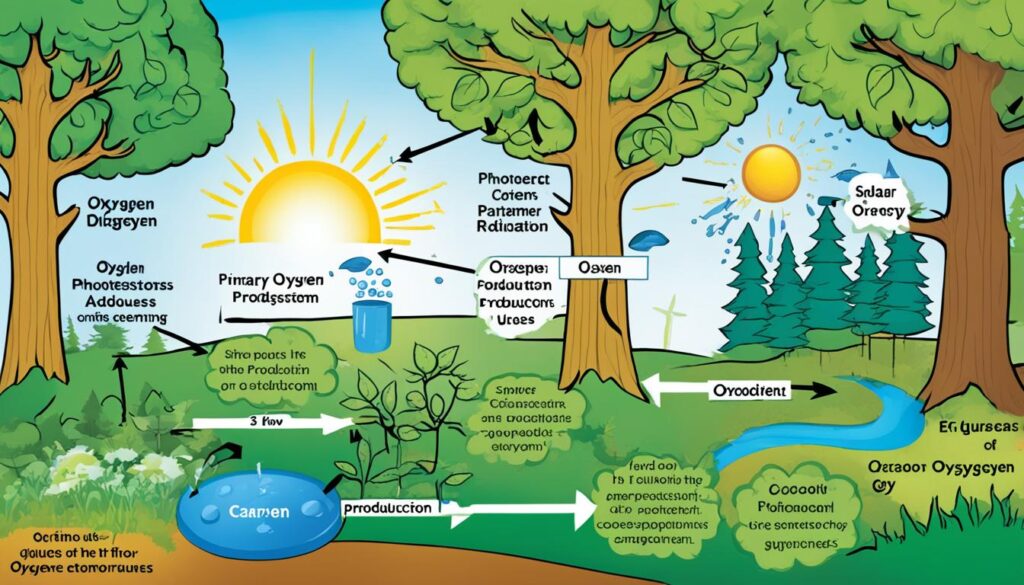Unlock Earth’s Secrets: Net Primary Productivity Equation

Have you ever wondered how scientists measure the productivity of ecosystems? How do they quantify the energy flow that sustains life on our planet? The answer lies in the net primary productivity equation, a powerful tool that reveals the hidden dynamics within Earth’s interconnected web of life.
Key Takeaways:
- The net primary productivity equation calculates the amount of organic matter produced by plants after considering respiration.
- Understanding net primary productivity helps scientists assess the health and productivity of ecosystems.
- The equation has applications in agriculture, forestry, conservation, and climate science.
- Challenges in measuring net primary productivity include variability in data collection methods and limitations in capturing belowground productivity.
- The net primary productivity equation provides valuable insights into Earth’s life-giving systems.
Understanding Net Primary Productivity
To truly comprehend the intricacies of Earth’s ecosystems, it is essential to delve into the concept of net primary productivity (NPP). NPP is a measure of the energy flow within an ecosystem, specifically the rate at which plants convert sunlight into usable energy through photosynthesis. By calculating NPP, scientists and researchers can gauge the productivity and overall health of these complex systems.
To calculate NPP, scientists employ various methods and measurements. One prevalent approach involves measuring the exchange of carbon dioxide (CO2) during the process of photosynthesis and plant respiration. This enables researchers to ascertain the net organic matter produced, which ultimately contributes to primary productivity.
In addition to carbon dioxide exchange, several factors influence net primary productivity. These include the availability of light, temperature, water, and essential nutrients. By quantifying these variables, scientists can estimate the primary productivity of an ecosystem, gaining profound insights into its functioning and overall health.
Consider the following factors that influence net primary productivity:
- Light Availability: The amount and intensity of sunlight reaching the plants directly impact their ability to photosynthesize and produce energy.
- Temperature: Plants have optimal temperature ranges for their metabolic processes, and deviations from these ranges can affect their NPP.
- Water Availability: Adequate water supply is crucial for the proper functioning of plant cells and the photosynthetic process. Limited water availability can hinder NPP.
- Nutrient Availability: Essential nutrients such as nitrogen, phosphorus, and potassium play a vital role in plant growth and energy production. Inadequate nutrient levels can limit NPP.
To further illustrate, let’s take a deeper look at the process of calculating NPP. Consider the table below:
| Measurement | Value |
|---|---|
| CO2 absorption during photosynthesis | 10,000 grams |
| CO2 release during plant respiration | 4,000 grams |
| Net primary productivity (NPP) | 6,000 grams |
This table showcases a simplified example of the calculations involved in determining NPP. By subtracting the amount of CO2 released during plant respiration from the CO2 absorbed during photosynthesis, we can calculate the net primary productivity.
Remember, NPP provides crucial insights into the functioning and dynamics of ecosystems. It helps us understand the energy flow and biomass production, enabling us to monitor ecosystem health, predict climate change impacts, manage resources more sustainably, and make informed conservation decisions.

By understanding and measuring net primary productivity, we become enlightened custodians of our planet, equipped with the knowledge necessary to protect and preserve Earth’s precious ecosystems.
The Importance of Net Primary Productivity
Net primary productivity (NPP) plays a critical role in understanding the dynamics of ecosystems and the overall health of our planet. It serves as a valuable metric in the fields of ecology and environmental science, shedding light on the energy flow and biomass production within ecosystems.
High net primary productivity indicates a thriving and productive ecosystem, characterized by abundant plant growth and a robust energy flow. On the other hand, low net primary productivity can indicate environmental stressors, such as limited resources or disturbances, which can negatively impact ecosystem health.
By analyzing and calculating the NPP rate, scientists can monitor the health of ecosystems, predict the effects of climate change, manage natural resources more effectively, and assess the sustainability of human activities. It provides insights into the overall functioning and resilience of our environment.
The NPP equation explanation allows us to quantify the primary productivity of ecosystems and understand the intricate relationships between plants, nutrients, and energy. It helps us comprehend the fundamental processes that sustain life on Earth and enables us to make informed decisions towards its conservation and preservation.
To illustrate the importance of net primary productivity, let’s take a look at a hypothetical example:
| High NPP | Low NPP | |
|---|---|---|
| Plant Growth | Lush vegetation and abundant biodiversity | Stunted growth and limited biodiversity |
| Energy Flow | Efficient conversion of sunlight into usable energy | Less energy available for ecosystem functioning |
| Resource Availability | Plentiful resources for both plants and animals | Limited resources, leading to competition and stress |
As you can see, high NPP indicates a thriving ecosystem with abundant resources, supporting diverse plant and animal communities. In contrast, low NPP suggests a struggling ecosystem with limited resources, leading to reduced biodiversity and potential ecological imbalances.
By understanding the importance of net primary productivity and the factors that influence its calculation, we can better appreciate the delicate balance of our natural world and work towards preserving its beauty and functionality for generations to come.

Applications of Net Primary Productivity
The net primary productivity equation is not only an invaluable tool for understanding ecosystems but also has numerous practical applications in various fields. By quantifying primary productivity, scientists can gain insights into the overall health and functioning of ecosystems, as well as make informed decisions in areas such as agriculture, forestry, conservation, and climate science.
Agriculture
In the field of agriculture, the net primary productivity equation can be used to optimize crop yields and assess the efficiency of farming practices. By understanding the primary productivity of different crops and regions, farmers can make educated decisions on irrigation, fertilizer application, and crop rotation, leading to improved agricultural productivity and sustainability.
Forestry
In forestry, accurate estimates of net primary productivity are crucial for sustainable forest management and timber production. By measuring the primary productivity of forests, forest managers can determine the appropriate harvesting levels, ensure the long-term viability of tree stands, and protect valuable ecosystems. This information is essential for balancing economic interests with environmental conservation.
Conservation
Net primary productivity plays a vital role in conservation efforts. Understanding primary productivity helps identify areas of high biodiversity and prioritize conservation actions. By assessing the primary productivity of different ecosystems, conservationists can pinpoint regions that are critical for maintaining high levels of biodiversity. This information can guide the establishment of protected areas and inform conservation strategies that aim to preserve fragile ecosystems.
Climate Science
Net primary productivity data is also invaluable for climate scientists studying carbon cycling and the impacts of climate change on ecosystems. By monitoring changes in primary productivity, researchers can assess the resilience of ecosystems to climate change and predict the future trends of carbon sequestration. This information is essential for developing effective mitigation strategies and understanding the feedback between climate change and ecosystem health.
| Field | Potential Applications |
|---|---|
| Agriculture | Optimizing crop yields, assessing farming practices |
| Forestry | Sustainable forest management, timber production |
| Conservation | Identifying areas of high biodiversity, prioritizing conservation actions |
| Climate Science | Studying carbon cycling, assessing impacts of climate change |
As you can see, the net primary productivity equation has wide-ranging applications that contribute to our understanding and management of Earth’s ecosystems. Whether it’s optimizing agricultural practices, guiding sustainable forest management, conserving biodiversity, or studying climate change, the net primary productivity equation provides valuable insights and tools for decision-making.

Challenges and Limitations of the Net Primary Productivity Equation
While the net primary productivity equation is a valuable tool in understanding and monitoring the productivity of Earth’s ecosystems, it does face certain limitations and challenges that need to be taken into account.
Variability in Measurement Techniques and Data Collection Methods
One challenge lies in the variability of measurement techniques and data collection methods used in calculating net primary productivity (NPP). Different researchers may employ different methods, leading to inconsistencies and uncertainties in the calculated NPP values. This variability in data collection can make it challenging to compare and interpret results across different studies or regions.
Estimating Belowground Primary Productivity
Another challenge is estimating belowground primary productivity, which is more difficult to measure compared to aboveground productivity. Belowground productivity refers to the amount of organic matter produced by plant roots and other belowground components of ecosystems. However, accurately quantifying belowground productivity requires techniques such as excavating and analyzing root systems, which can be time-consuming and labor-intensive.
Incomplete Representation of Ecosystem Dynamics
The net primary productivity equation may not fully capture all aspects of ecosystem functioning and dynamics. While it focuses on the energy flow through plants and their production of organic matter, it does not account for the role of decomposers and detritus in nutrient cycling. These organisms play a vital role in breaking down organic matter and recycling nutrients back into the ecosystem, influencing the overall productivity of the system.

| Challenges | Solutions |
|---|---|
| Measurement variability | Standardizing measurement techniques and data collection methods |
| Estimating belowground productivity | Developing advanced techniques for accurate belowground measurements |
| Incomplete representation of ecosystem dynamics | Incorporating detritus and decomposer dynamics into productivity models |
Despite these challenges, the net primary productivity equation remains a vital tool for understanding and monitoring the productivity of Earth’s ecosystems. By acknowledging these limitations and working towards improved measurement methods, we can continue to gain valuable insights into the functioning and dynamics of our planet’s intricate life-supporting systems.
Conclusion
The net primary productivity equation is a powerful tool that allows you to unlock the secrets of Earth’s ecosystems. By calculating the net amount of organic matter produced by plants after considering respiration, you can gain valuable insights into the energy flow, productivity, and overall health of ecosystems. Whether you’re studying agriculture, forestry, conservation, or climate science, the net primary productivity equation is a crucial component of your work.
Applying the NPP formula, you can assess the productivity and sustainability of agricultural practices, optimize crop yields, and make informed decisions about land management. In forestry, the equation helps guide sustainable forest management practices, ensuring the long-term health of our forests. For conservationists, understanding net primary productivity can help identify areas of high biodiversity and prioritize conservation efforts.
Moving forward, the net primary productivity equation will continue to play a vital role in our understanding and management of Earth’s life-giving dynamics. While there are challenges in measuring and using the NPP formula, such as the variability in measurement techniques and potential limitations in capturing belowground productivity, it remains an essential tool for researchers, scientists, and policymakers alike. By harnessing the power of the net primary productivity equation, we can make more informed decisions to ensure the sustainability and well-being of our planet.





